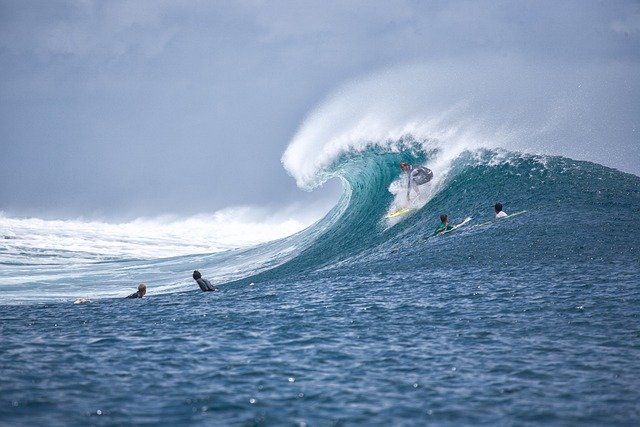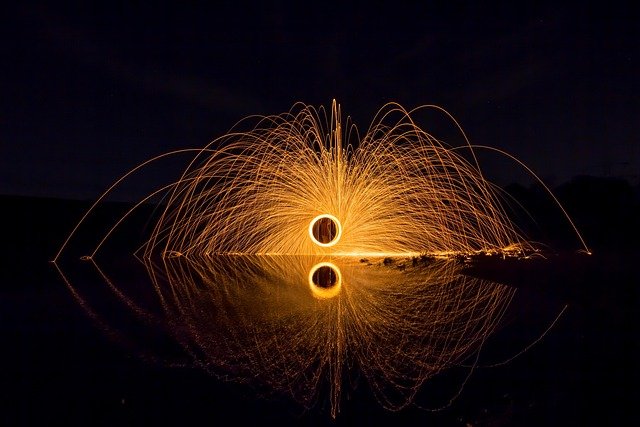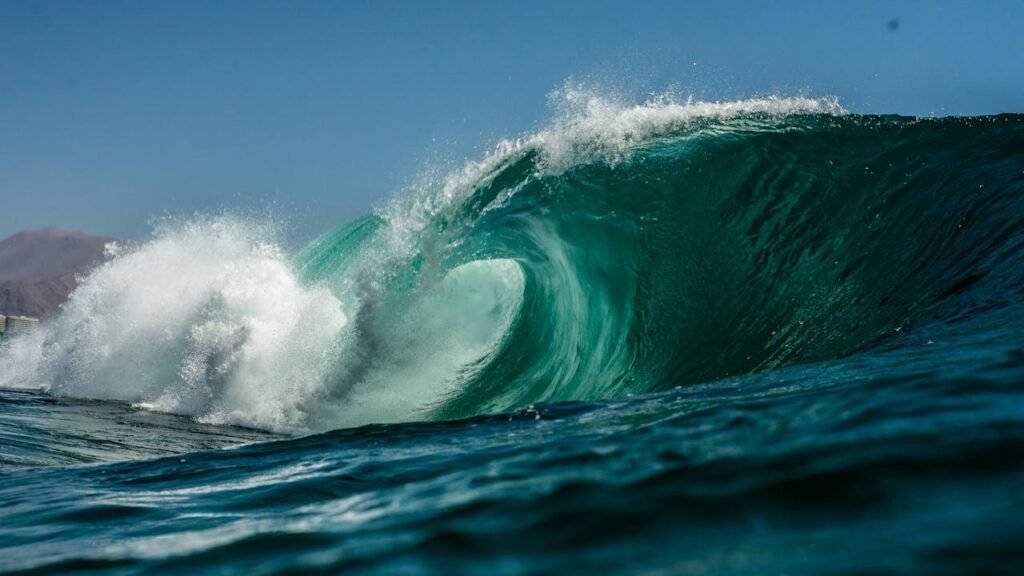When most people think of waves, they imagine the ocean — water rolling toward the shore, one after another. But waves are much more than that. They’re all around us, even in places where there’s no water at all. The sound of someone’s voice, the warmth of sunlight, the signal that lets you watch videos on your phone — all of these are carried by waves.
Waves are simply a way for energy to move from one place to another. Sometimes they move through water, sometimes through air, and sometimes through invisible fields. Once you understand how waves work, you’ll start seeing them everywhere — in nature, in technology, and even inside your own body.
In this article, we’ll explore what waves are, the different kinds that exist, and how they connect things as different as the pull of the Moon on our oceans and the Wi-Fi signal in your home. We’ll keep it simple and full of real-life examples so you can understand waves in a way that makes sense instantly.
What Exactly Is a Wave?
A wave is a repeating movement that carries energy from one place to another without moving matter from one place to another in the same way. In other words, the thing you see moving — like the water in an ocean wave — is not actually traveling all the way from the middle of the sea to the shore. The water particles move in a small path, but the energy in the wave keeps going forward.
Think about this: if you drop a pebble into a calm pond, ripples spread outward. The water itself doesn’t move across the pond to the edges — instead, each bit of water passes the movement to the bit next to it, like a chain reaction. That’s how energy travels in a wave.
The Two Main Types of Waves

Even though waves can happen in many forms, scientists often group them into two main types based on how the particles move:
1. Transverse Waves
In a transverse wave, the particles move up and down while the energy moves forward.
Example: Imagine shaking a jump rope up and down. The rope moves up and down, but the wave travels along its length toward the other person holding it. Ocean waves are transverse — the water moves up and down, but the energy moves toward the shore.
2. Longitudinal Waves
In a longitudinal wave, the particles move back and forth in the same direction that the energy moves.
Example: Sound waves are like this. When you speak, your vocal cords push air particles closer together in some spots and farther apart in others. These tiny movements travel forward through the air until they reach someone’s ear.
Why Waves Matter
Waves aren’t just a science topic — they’re the reason we can hear music, talk to someone far away, see light from the Sun, and send messages through the internet. Without waves, there would be no radio, no phone calls, and no ocean tides.
How Waves Travel
Waves move by transferring energy between particles or through fields. But not all waves need a physical material to travel.
- Mechanical waves need matter (like water, air, or a solid surface) to move through. Sound is one of these — it can’t travel through space because there’s no air or other matter for it to pass through.
- Electromagnetic waves don’t need matter — they can travel through empty space. Light, Wi-Fi, and X-rays are all electromagnetic waves. That’s how sunlight can reach Earth from the Sun, even though there’s nothing but space in between.
The Energy in Waves
The bigger or stronger the wave, the more energy it carries. That’s why a giant ocean wave can knock you over, while a small ripple just tickles your feet. The same is true for sound — a loud bang carries more energy than a whisper, which is why it’s harder on your ears.
Ocean Waves – More Than Just Water Moving

When you see waves rolling toward the shore, it might seem like the water is traveling with them. But most of the water doesn’t actually move forward. Instead, the water particles move in small circular paths — up, forward, down, and back again — while the energy of the wave travels toward the land.
Ocean waves can be caused by many things:
- Wind – The most common cause. As wind blows across the surface of the water, it transfers energy to the water, creating waves.
- Earthquakes – These can create massive waves called tsunamis. Unlike normal waves, tsunamis carry energy through the whole depth of the ocean.
- Boats and ships – Moving vessels push water aside, creating small waves called wakes.
The size and strength of a wave depend on how strong the wind is, how long it blows, and how far it travels over the water (this distance is called the fetch).
Tides – The Ocean’s Gentle Rise and Fall
Tides are different from waves. While waves are mostly caused by wind, tides are caused by the pull of gravity from the Moon and the Sun.
The Moon’s gravity pulls on Earth’s oceans, making the water bulge out in the direction of the Moon. At the same time, another bulge happens on the opposite side of the planet. These bulges are high tides. The areas between them have low tides.
As the Earth rotates, different places on the planet move into and out of these bulges, which is why most coasts experience two high tides and two low tides every 24 hours.
Why the Moon Has the Strongest Effect
You might think the Sun, being much bigger, would have a stronger pull on our tides. But the Moon is much closer to Earth, so its gravitational effect on the oceans is stronger.
However, the Sun still plays a role. When the Sun, Moon, and Earth are lined up (during full moons and new moons), their gravity combines to make spring tides — the highest high tides and the lowest low tides. When the Sun and Moon are at right angles to each other (during quarter moons), we get neap tides, which are gentler.
Why Tides Are Important
Tides affect more than just beach walks. They:
- Control where boats can safely enter and leave harbors.
- Affect fishing, because certain fish move with the tides.
- Shape coastlines over time through erosion.
- Provide potential energy for tidal power stations, which can generate electricity.
Sound Waves – How We Hear the World

Sound is a type of mechanical wave, which means it needs something to travel through — like air, water, or a solid object. You can’t hear sound in space because there’s no matter for the wave to move through.
When something vibrates — like guitar strings, your vocal cords, or a speaker — it pushes the particles of the material around it. These particles bump into the next ones, and those bump into the next, passing the vibration forward.
The particles don’t travel all the way from the source to your ear. Instead, the vibration moves through them like a relay race, carrying energy from the sound source to you.
Why Your Recorded Voice Sounds Different
When you speak, the sound you hear is partly traveling through the air into your ears, but also partly traveling through the bones and tissues of your head. This second path makes your voice sound deeper and fuller to you.
When you hear a recording, that “inside your head” pathway is missing. You only hear the sound traveling through the air, so it often sounds higher or thinner than you expect.
Loudness – The Energy of Sound
Loudness depends on the amplitude of a sound wave — how big the vibrations are. Bigger vibrations push air particles more, creating a louder sound.
- A whisper has small vibrations, so it’s quiet.
- A drum hit hard has large vibrations, so it’s loud.
We measure loudness in decibels (dB). Normal conversation is around 60 dB, while a rock concert can reach over 100 dB. Long exposure to very loud sounds can damage your hearing because the strong vibrations can harm the tiny hair cells in your inner ear.
Pitch – The Speed of Vibration
Pitch depends on the frequency of a sound wave — how many times the particles vibrate each second. We measure frequency in hertz (Hz).
- Low-pitched sounds (like a bass drum) have slow vibrations.
- High-pitched sounds (like a whistle) have fast vibrations.
Humans can usually hear sounds between 20 Hz (very low) and 20,000 Hz (very high). Some animals can hear beyond this range — dogs, for example, can hear whistles that are too high for us to detect.
Sound Waves in Action
Sound waves can bounce (echo), bend around corners, and even travel through walls — though the walls might muffle them by absorbing some of the energy. That’s why you can sometimes hear music from another room, but it sounds softer and duller.
Understanding how sound works helps us design better speakers, build concert halls with great acoustics, and even create ultrasound machines for medicine.
Light Waves – Energy You Can See

Light is part of a family of waves called electromagnetic waves. These waves are different from sound and water waves because they don’t need matter to travel through — they can move through empty space. That’s why sunlight can reach Earth from 150 million kilometers away.
Light waves are made up of vibrating electric and magnetic fields that move together. These fields create a wave that carries energy at an incredible speed — about 300,000 kilometers per second (the speed of light).
When light reaches our eyes, it allows us to see. The colors we see depend on the wavelength of the light. Shorter wavelengths appear blue or violet, while longer wavelengths appear red.
The Electromagnetic Spectrum
Light is just one part of the electromagnetic spectrum. This spectrum includes many kinds of waves, all traveling at the same speed but with different wavelengths and frequencies.
Here are some examples from longest wavelength to shortest:
- Radio waves – Used for broadcasting, TV, and Wi-Fi.
- Microwaves – Used for heating food and satellite communication.
- Infrared – Felt as heat; used in remote controls.
- Visible light – The part we can see.
- Ultraviolet (UV) – From the Sun; can cause sunburn.
- X-rays – Used in medicine to see inside the body.
- Gamma rays – The most energetic; found in radioactive decay and space explosions.
Even though they have different uses, they all share the same basic nature: they are electromagnetic waves carrying energy.
How Wi-Fi Uses Waves
Wi-Fi works by sending and receiving radio waves between your device and a router. These waves carry data in patterns of quick changes — a bit like Morse code, but much faster and invisible.
Your phone, laptop, or tablet has tiny antennas that detect these waves and turn them into information — like a video, a song, or a web page.
X-Rays – Waves That See Through You
X-rays have much shorter wavelengths than visible light, which gives them more energy. This extra energy allows them to pass through soft tissues in the body but not through denser materials like bones. That’s why doctors can use them to take pictures of your skeleton.
Why Electromagnetic Waves Are Amazing
Electromagnetic waves connect so many parts of our lives — from the light that wakes you up in the morning to the signals that let you talk to someone on the other side of the planet. Without them, there would be no TV, no mobile phones, no internet, and no sunlight reaching Earth.
How Waves Connect Nature and Technology
One of the most powerful lessons we can teach kids about waves is that they are not just a “science topic” for school. Waves are part of the deep connection between the natural world and human-made technology. The same basic principles explain why the ocean has tides, how whales talk to each other, and how a Wi-Fi signal lets you video chat with someone across the world.
When children see that these very different things are actually linked by the same rules of physics, science becomes something living, exciting, and relevant to everyday life.
Waves in Nature – The Earth’s Rhythm
Nature is full of waves that keep our planet moving and thriving:
- Ocean Waves – Powered mainly by the wind, they move vast amounts of energy across the sea. These waves shape coastlines, carry nutrients for marine life, and help mix oxygen into the water so fish and plants can survive.
- Tidal Waves – Not the disaster kind, but the gentle rise and fall of ocean tides caused by the Moon’s pull on Earth’s water. Tides control the daily rhythm for many coastal creatures and influence fishing and sailing schedules.
- Sound Waves in Animals – Whales sing songs that can travel for hundreds of kilometers under water. Bats use high-frequency sound waves to bounce off objects and find their way in the dark — a skill called echolocation.
- Light Waves from the Sun – These waves carry energy across empty space to warm our planet, drive weather patterns, and allow plants to perform photosynthesis — the process that creates the oxygen we breathe.
In nature, waves are not just background noise — they are the heartbeat of the planet.
Waves in Technology – Energy with a Purpose
Humans have learned to harness wave energy for countless uses:
- Radio Waves – Carry voices, music, and information to radios and televisions across great distances.
- Microwaves – Heat food quickly in kitchens and send signals to satellites in space.
- Infrared Waves – Carry warmth from heaters and allow night-vision cameras to “see” in the dark.
- X-Rays – Pass through soft tissue but not bone, helping doctors see inside the human body.
- Wi-Fi Signals – Use high-frequency radio waves to send videos, games, and files between devices almost instantly.
These technologies all rely on the same science of wave movement — controlling wavelength, frequency, and amplitude to carry the right kind of energy or information.
The Connection That Inspires Curiosity
When students learn that the same wave principles explain both a crashing ocean wave and a message sent from a phone, something changes. Science stops feeling like separate, unrelated topics and starts to feel like one connected story.
They begin to notice patterns — the way ripples in water look like the diagrams of sound waves, or how the rise and fall of a tide is similar to the cycle of a radio signal. This kind of big-picture thinking sparks deeper curiosity and helps children make sense of the world in a way that sticks for life.
How Debsie Helps Kids Master the Science of Waves

At Debsie, we know that science becomes magical when it moves from something children read about to something they can see, hear, feel, and test for themselves. Waves are the perfect example. They are everywhere — in the ocean, in the air, in music, in light, even in the signals that make your phone work. But because many waves are invisible, they can feel like a mysterious idea rather than a real thing.
Our mission is to make waves real for every student. We do this by combining expert teaching, playful experiments, and relatable examples so that children not only understand the science but also see how it shapes their everyday lives.
1. We Turn the Invisible into Something Kids Can See and Touch
Waves are often hard to picture. That’s why our teachers use activities that make them visible. In a live class, a teacher might stretch a rope across the room and show how moving one end sends a ripple to the other. Students can do the same at home with a skipping rope.
For sound waves, we might place rice grains on a drum skin so children can watch the grains dance when the drum is hit. For light waves, we use prisms to split white light into a rainbow right before their eyes. This way, they’re not just hearing “waves exist” — they’re watching them in action.
2. We Bring Waves into Everyday Life
We believe kids learn best when they see how lessons connect to things they already know. In our classes, waves aren’t just “a science topic” — they’re explained through:
- The way ocean tides affect fishing.
- How a favorite song travels through the air into headphones.
- Why Wi-Fi works faster in some places than others.
When science is tied to real life, it sticks in a child’s mind.
3. We Let Kids Be the Scientists
Instead of giving all the answers, we give children the tools to discover them. A “wave mission” might ask them to:
- Build a mini ocean in a baking dish and test what makes bigger waves.
- Shine light through different colored bottles to see which blocks more light.
- Compare how well different materials carry sound.
These challenges turn learning into an adventure — kids become curious investigators, not just passive listeners.
4. We Teach at the Right Level for Every Age
Our partner teachers are experienced with children from 5 to 18 years old. For younger learners, we explain waves with simple actions — like moving toys in water or using hands to clap out a sound rhythm. For older learners, we dive deeper into wave speed, frequency, and energy, even introducing the maths behind it.
5. We Build Skills Beyond Science
Every wave lesson builds more than knowledge. Kids learn to:
- Observe small details.
- Predict what will happen and then test their ideas.
- Explain what they see in their own words.
These are the thinking skills they’ll use in every subject — and in life.
6. We Create a Global Learning Space
Because Debsie students join from many countries, wave lessons often spark discussions about how waves affect people differently — from surfers in Australia catching the perfect wave, to children in the UK learning about tides, to students in Asia discussing how monsoons and sea waves are connected.
This global view makes science richer and shows kids how connected the world really is.
Conclusion
Waves are everywhere — rolling across the ocean, traveling through the air as sound, streaming invisibly between devices, and even crossing the vast emptiness of space as sunlight. They are one of nature’s most powerful tools for moving energy and information.
When kids understand waves, they see the world differently. They notice how the Moon’s pull shapes the tides, how their favorite song travels from a speaker to their ears, and how a Wi-Fi signal lets them talk to someone thousands of kilometers away. Science becomes more than a school subject — it becomes a way to make sense of life itself.
At Debsie, we believe that every child deserves to experience that “aha” moment — the moment they realize that learning science means unlocking the secrets of the world. Through live classes, hands-on experiments, creative challenges, and engaging storytelling, our teachers make sure that wave science is not only understood but remembered and loved.
Whether your child dreams of being a scientist, an engineer, or simply wants to understand how things work, learning about waves with Debsie is a step toward a smarter, more curious, and more confident future.
🌊 Ready to help your child ride the wave of curiosity? Sign up for a free trial class at Debsie.com today — and watch them light up as they discover the science that connects the oceans, the air, and the digital world.
Read next:
